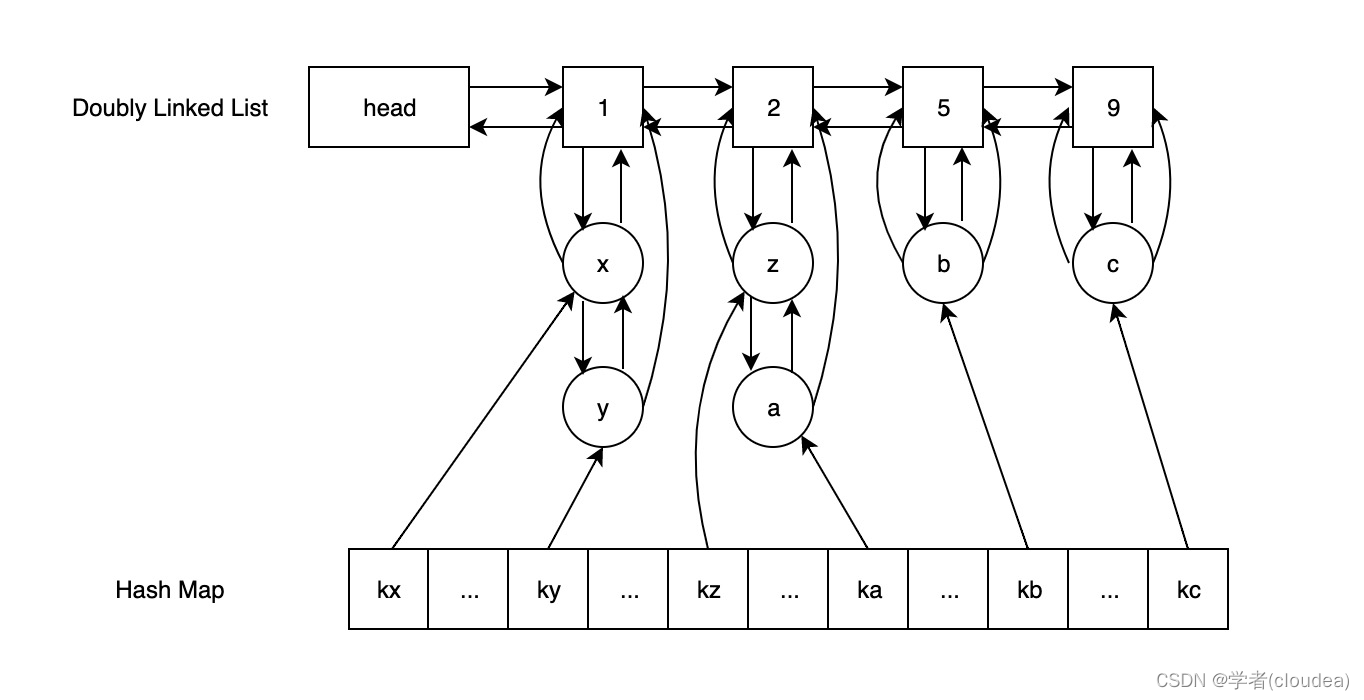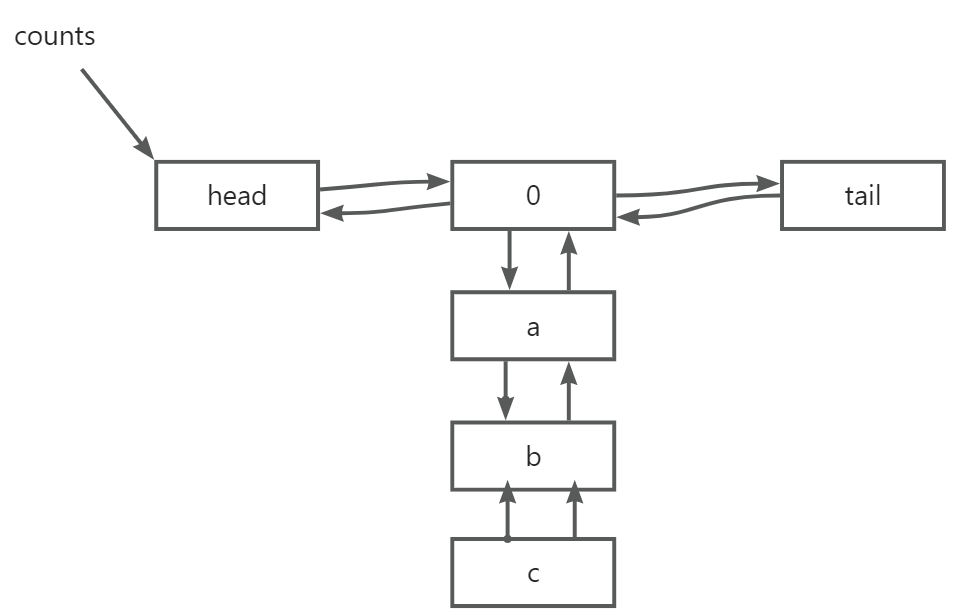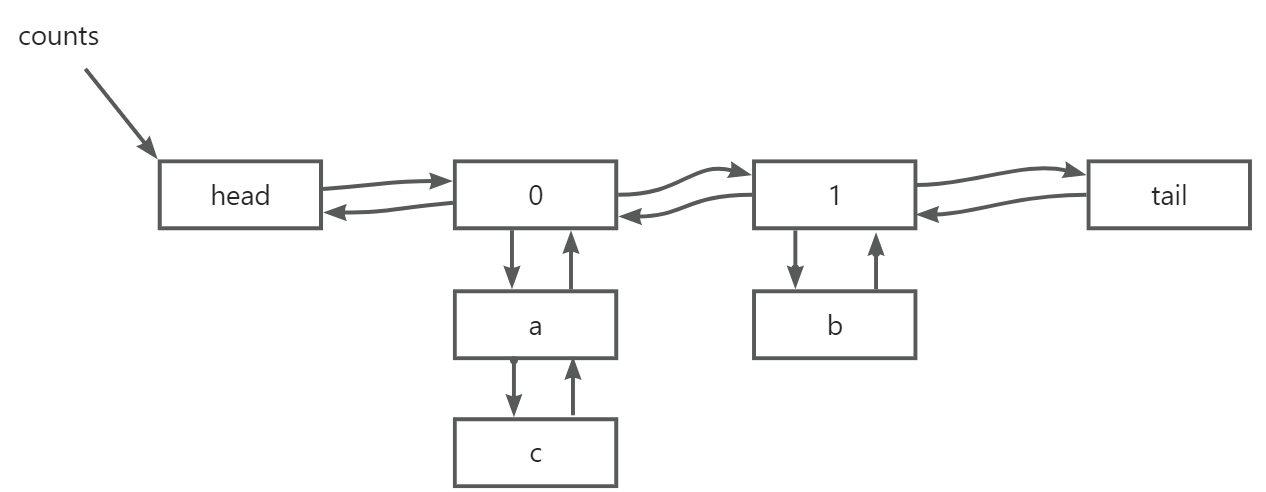一种具有O(1)复杂度的LFU算法实现(java 实现)
创始人
2025-05-29 13:59:12
0次
最近在做一些数据缓存方面的工作。研究了LRU算法和LFU算法。
- LRU有成熟的O(1)复杂度算法:参考:https://juejin.cn/post/7055600927671058469
- LFU最佳实现方法是O(log n)的。但项目中要求算法高效,所以学习了O(1)复杂度的算法实现:参考: https://tech.ipalfish.com/blog/2020/03/25/lfu/
算法本质上是维护一个如图的数据结构:
- 一个HashMap
- 一个双向链表(链表元素又是一个双向子链表,具有相同访问次数的数据会放在相同的链表中)。

此时聪明的你应该想到如何实现了!下面以一个例子说明其原理。为了画图方便。省略了两类指针:
- HashMap指向子链表元素的指针
- 双向子链表元素指向双向链表节点的指针
在本文的实现中,初始时只有一个频次为0的链表:

当加入值时,都默认放在这个频次为0的链表中。比如添加a, b, c后。

当获取值时,会把它的频次加1,以b为例,即会把b移动到一个新的链表。

当缓存不足时,将优先淘汰访问频次最小的。可以从head开始查找,将找到的第一个从链表中删除即可。即会把a删除,删除后如图。

无论是加入、获取、淘汰,操作的复杂度都是O(1)的。
package com.iscas.intervention.data.cache;import java.util.HashMap;/*** O(1) 的LFU实现* @author cloudea* @date 2023/03/17*/
public class LFU {/*** 保存数据的双向链表结点*/public static class LFUListNode {public String key;public Object value;public LFUListNode last;public LFUListNode next;public LFUDoubleListNode master; // 指向所属的频次节点public LFUListNode(String key, Object value) {this.key = key;this.value = value;}}/*** 保存频次的双向链表节点*/public static class LFUDoubleListNode {public int count; // 频次public LFUListNode head ;public LFUListNode tail;public LFUDoubleListNode last;public LFUDoubleListNode next;public LFUDoubleListNode (int count){this.count = count;// 初始化哨兵this.head = new LFUListNode(null, null);this.tail = new LFUListNode(null, null);this.head.next = this.tail;this.tail.last = this.head;}}/*** 频次双向链表*/public static class LFUDoubleList {public LFUDoubleListNode head;public LFUDoubleListNode tail;public LFUDoubleList(){this.head = new LFUDoubleListNode(0);this.tail = new LFUDoubleListNode(0);this.head.next = this.tail;this.tail.last = this.head;}}private HashMap caches = new HashMap<>();private LFUDoubleList counts = new LFUDoubleList();public LFU(){// 初始化访问频次为0的结点LFUDoubleListNode lfuDoubleListNode = new LFUDoubleListNode(0);lfuDoubleListNode.last = counts.head;lfuDoubleListNode.next = counts.tail;counts.head.next = lfuDoubleListNode;counts.tail.last = lfuDoubleListNode;}public void set(String key, Object value){if(caches.containsKey(key)) {// 如果存在,则更新一下value即可caches.get(key).value = value;}else{// 否则,需要放入链表中(放入频率为0的链表)LFUListNode node = new LFUListNode(key, value);node.master = counts.head.next;node.last = node.master.tail.last;node.next = node.master.tail;node.last.next = node;node.next.last = node;caches.put(key, node);}}public Object get(String key){if(caches.containsKey(key)){// 如果存在,直接返回,然后更新频次 (频次加1)LFUListNode node = caches.get(key);LFUDoubleListNode nextMaster = node.master.next;if(nextMaster.count != node.master.count + 1) {// 新建一个master节点LFUDoubleListNode A = node.master;LFUDoubleListNode B = node.master.next;LFUDoubleListNode n = new LFUDoubleListNode(node.master.count + 1);n.last = A;n.next = B;A.next = n;B.last = n;nextMaster = n;}// 把结点从当前master删除node.last.next = node.next;node.next.last = node.last;// 把结点加入到下一个masternode.last = nextMaster.tail.last;node.next = nextMaster.tail;node.last.next = node;node.next.last = node;node.master = nextMaster;// 返回节点值return node.value;}return null;}/*** 删除频次最小的元素*/public Object remove(){if(size() != 0){for(var i = counts.head.next; i != counts.tail; i = i.next){for(var j = i.head.next; j != i.tail; j = j.next){// 删除当前元素j.last.next = j.next;j.next.last = j.last;// 删除当前master(如果没有结点的话)if(j.master.head.next == j.master.tail){if(j.master.count != 0){j.master.last.next = j.master.next;j.master.next.last = j.master.last;}}// 从hashmap中删除caches.remove(j.key);return j.value;}}}return null;}public int size(){return caches.size();}
} 相关内容
热门资讯
当对手都在做下沉 蜜雪冰城旗下...
[ 今年5月,蜜雪集团跟巴西签署40亿元人民币的采购意向大单,其中大多数是咖啡豆。 ] 当星巴克、瑞...
新手必看!股指期货交易规则基础...
股指期货交易规则,看似复杂抽象,实则与我们的日常生活有着奇妙的共通之处。它就像一场精心编排的生活交响...
王登发履新茅台技开公司“一把手...
一则微信公众号发布的信息,披露了茅台集团旗下的技术开发公司“一把手”已换人。 近日,南都湾财社-酒水...
特斯拉机器人V3量产版亮相!马...
快科技7月27日消息,特斯拉的Optimus人形机器人V3量产版终于要来了!马斯克在最近的财报电话会...
原创 中...
在金融全球化的浪潮中,中国资本市场始终勇立潮头,不断探索前行。7月26日,中国资本市场学会成立大会暨...
报告:我国经济增长保持韧性 下...
央广网北京7月27日消息(记者 樊瑞)近日,中国金融四十人论坛(CF40论坛)发布《2025年第二季...
超6300亿元!A股银行“分红...
7月25日,成都银行完成权益分派股权登记,将于7月28日发放现金红利,这标志着A股上市银行2024年...
老铺黄金:2025年上半年单个...
7月27日晚,老铺黄金(HK06181)披露2025年中期业绩预告。预计2025年上半年实现销售业绩...
保险行业2025年上半年回顾与...
今天分享的是:保险行业2025年上半年回顾与未来展望 报告共计:59页 2025年上半年保险行业回顾...
数币App上新!消费者、商户两...
数字人民币试点持续推进,相关数字钱包手机应用程序功能也在优化中。7月21日,北京商报记者注意到,日前...
A股热点迭出,个股连续涨停!资...
近段时间以来A股市场整体走势较为强劲,上周以来在雅江概念集体上行的推动下涨势更为明显,主要指数不同程...
原创 印...
令人惊讶的是,印度人开始反思自身制造业的发展状况。印度经济学家帕纳加利亚指出,印度原本有机会在20年...
首创证券拟赴港上市,“A+H”...
首创证券在A股上市不足三年便启动赴港上市计划。近日,首创证券公告称,公司董事会已审议通过了公司拟发行...
肥东杨大爷要帮“儿子”还钱,银...
“儿子”在外借了2万元还不上 “要债人”电话直接打了过来 还?还是不还? 7月6日 肥东县公安局梁园...
A股上周16家上市公司公布并购...
转自:扬子晚报 扬子晚报网7月27日讯(记者 范晓林 薄云峰)近段时间以来,A股市场并购重组活跃度持...
独家|某股份行改动零售业务关键...
在资产端信贷“投不动”(多家行零售信贷增速连续几个季度放缓、更有甚者个贷投放负增长)、负债端存款“定...
四川五日游报团指南及详细行程,...
四川,这片位于中国西南的神奇土地,以其独特的自然风光、丰富的文化遗产和诱人的美食而闻名遐迩。从成都的...
原创 中...
在2025年4月初,时任美国总统的特朗普正式启动了针对世界各国的关税战,旨在通过实施经济制裁来促进美...
牛市主升浪开启了?别急!珍惜布...
本周,A股市场上行,主要宽基指数都收获了或多或少的周涨幅,其中,科创50、微盘股涨幅居前。板块方面,...
公募二季报两大看点!港股配置逼...
本报(chinatimes.net.cn)记者栗鹏菲 叶青 北京报道 2025年公募基金二季报披露收...
